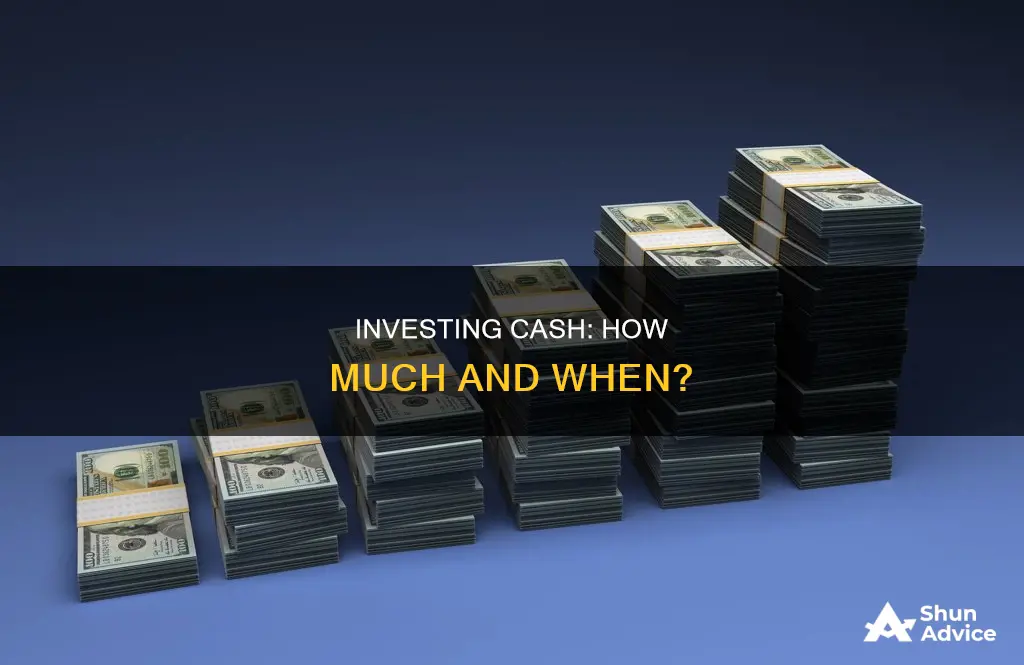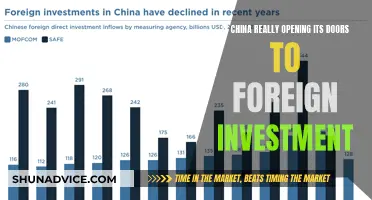
Cash investments are a short-term, low-risk option for investors who want to preserve their capital while they research other investment products. They are also useful for those who need a temporary place to keep their money. Cash investments are FDIC-insured and provide a return in the form of interest payments. Money market accounts and certificates of deposit are examples of cash investments.
The amount of cash that should be invested depends on an individual's financial situation and goals. Generally, cash and cash equivalents should make up between 2% and 10% of a portfolio. However, some investors keep as much as 20% to 30% of their portfolios in cash.
Cash investments can provide liquidity, portfolio stability, and emergency funds. They are also useful for those who are risk-averse or seeking a temporary safe haven during volatile markets.
| Characteristics | Values |
|---|---|
| Purpose | Emergency fund, money to be invested, temporary place to keep cash |
| Timeframe | Short-term (under 90 days) |
| Risk | Low |
| Returns | Low |
| Accessibility | High |
| Examples | Money market accounts, certificates of deposit |
What You'll Learn

Emergency funds
The amount required for an emergency fund varies depending on individual circumstances. Most financial experts recommend having the equivalent of six months' worth of income or expenses. This means that if your monthly expenses are $5,000, you should aim to save $30,000. However, some experts suggest a fund that covers eight months' worth of expenses, while others suggest three months, depending on factors such as debt, insurance, and liquid investments.
It is important to note that this emergency fund should be separate from any other savings or investments. Once you have built up your emergency fund, you can start allocating your savings towards retirement or other financial goals.
While keeping your emergency fund in an investment account with relatively safe allocations can earn you more interest, it is crucial to ensure that the money is still instantly accessible and insured. Some people choose to keep a small amount of physical cash, such as $100 to $300, in their wallet, and a larger amount, such as $1,000, at home in a safe for unexpected expenses.
In addition to an emergency fund, it is also recommended to have some cash set aside for investment opportunities. This money should be kept in accounts that can be accessed relatively quickly and should be separate from your emergency savings.
Understanding the Investing Activities on a Cash Flow Statement
You may want to see also

Liquidity
The amount of cash that should be invested depends on several factors, including an individual's financial situation and budget, risk tolerance, and current life stage. As a general rule of thumb, cash and cash equivalents (such as savings and checking accounts) should comprise between 2% and 10% of an investment portfolio. However, this can vary depending on personal circumstances and financial goals.
Cash Investments
Cash investments are typically short-term obligations, usually fewer than 90 days, that provide a return in the form of interest payments. Examples of cash investments include money market accounts (MMAs) and certificates of deposit (CDs). These investments are considered low-risk and offer high liquidity, allowing investors to access their money within a short period.
Emergency Funds
It is recommended to keep enough cash on hand to cover emergency expenses. Most financial experts suggest having the equivalent of at least three to six months' worth of income or expenses in a liquid emergency fund. This provides a safety net in case of unexpected disasters or financial difficulties.
Cash as a Defensive Strategy
Holding a significant amount of cash in a portfolio can be a defensive strategy in case asset markets decline. It allows investors to hold onto their assets instead of being forced to sell at a loss during a market downturn.
Cash as an Offensive Strategy
Cash can also be used offensively. When asset prices fall, investors with cash reserves can take advantage of the lower prices and invest in assets at a discount.
Diversification
Diversifying a portfolio across different asset classes, including cash, stocks, and bonds, can help minimize losses and maximize returns over the long term.
In summary, liquidity is an important consideration when deciding when and how much cash to invest. It provides flexibility, safety, and opportunities to take advantage of market conditions. The appropriate level of cash to hold depends on individual circumstances, financial goals, and risk tolerance.
Negate Investing: Cash Flow Conundrum?
You may want to see also

Peace of mind
Firstly, it is recommended that individuals keep enough cash to cover their regular monthly bills and expenses. This includes fixed costs such as rent, utilities, and insurance, as well as discretionary spending on food, entertainment, and other variable costs. Having a buffer in your checking account can also provide peace of mind, as long as it doesn't tempt you to overspend.
Secondly, it is generally advised to have an emergency fund containing enough cash to cover at least three to six months' worth of living expenses. This fund should be easily accessible and separate from your everyday checking account. It can be kept in a high-yield savings account, offering a small amount of interest, or in other liquid investments that carry minimal risk. This emergency fund provides peace of mind by ensuring you have financial resources to fall back on in case of unexpected disasters, such as job loss, accidents, or medical bills.
Thirdly, peace of mind can also come from having a well-diversified investment portfolio. While cash investments, such as money market accounts and certificates of deposit (CDs), are considered safe and liquid, they often provide low returns that may not keep up with inflation. Therefore, it is important to also consider investing in stocks, bonds, or other assets that offer higher potential returns over the long term. Diversification helps minimize losses and maximizes the chance of gains, providing peace of mind during volatile market conditions.
Finally, for those with more substantial wealth, maintaining a larger cash position can provide peace of mind by offering defensive benefits during market downturns and the flexibility to take advantage of investment opportunities. However, this approach may sacrifice the potential for higher returns associated with a more aggressive investment strategy.
In conclusion, peace of mind when deciding how much cash to keep or invest depends on several factors, including your financial situation, budget, risk tolerance, and investment goals. By covering essential expenses, maintaining an emergency fund, diversifying investments, and considering the benefits of a larger cash position, individuals can make informed decisions that balance safety and potential returns.
Understanding Cash Equivalent Investments: Basic Features Explained
You may want to see also

Avoiding overdraft fees
Overdraft fees can be a frustrating and costly issue, but there are several strategies you can use to avoid them. Here are some detailed and direct tips to help you avoid overdraft fees:
Opt Out of Overdraft Coverage
You have the right to opt out of overdraft coverage, which means your bank will decline a transaction if there are insufficient funds in your account. This is a better option than incurring multiple overdraft fees for purchases when your account is overdrawn.
Regularly Monitor Your Account Balance
Check your account balance frequently, especially if you have an uneven or low income. Most overdraft fees from debit cards occur on transactions of $24 or less, so keeping a close eye on your balance can help you avoid these fees.
Set Up Alerts for Low Balances
Automate the process of checking your balance by setting up alerts. Most banks offer the option to receive email or text notifications when your account balance drops below a certain threshold. This can help you stay on top of your finances and prevent overdrafts.
Link Your Checking Account to Another Account
You can link your checking account to a savings account, line of credit, or credit card as overdraft protection. This way, if you make a transaction that would result in an overdraft, the difference will be covered by the linked account. However, remember to pay back any amounts borrowed, and be aware of any associated fees or interest charges.
Use a Prepaid Debit Card
Prepaid debit cards have built-in spending limits and cannot be overdrawn, making them a useful tool to avoid overdraft fees. These cards are not linked to checking accounts, so transactions that exceed the available funds will simply be declined.
Switch to a Bank with a Generous Overdraft Policy
Some banks have more favourable overdraft policies, such as only charging fees if you overdraw by a certain amount or offering grace periods. Shop around and compare bank policies to find one that suits your needs and helps you avoid excessive overdraft fees.
Keep a Cushion in Your Account
While it may not always be possible, maintaining a "pad" of extra money in your checking account can act as a safety net and help prevent overdrafts. This buffer can give you some breathing room and prevent unexpected fees.
By implementing these strategies and staying vigilant with your finances, you can effectively avoid overdraft fees and maintain better control over your financial situation.
The Future of Super: Cash Investments' Safety Net
You may want to see also

Avoiding taxes and suboptimal returns
When it comes to investing, taxes can significantly reduce your returns. Implementing a tax-efficient investing strategy can help you avoid overpaying taxes and maximise your investment's growth potential. Here are some ways to avoid taxes and suboptimal returns when investing a large sum of cash:
Understand Tax-Efficient Investing:
Tax-efficient investing involves selecting investment strategies and accounts that minimise the taxes owed on your returns. There are two main types of investment accounts: taxable and tax-advantaged. Taxable accounts, such as brokerage and individual investment accounts, offer flexibility in contributions and withdrawals but are subject to taxation on returns. On the other hand, tax-advantaged accounts like IRAs and 401(k)s have tax benefits but come with annual contribution limits and restrictions on withdrawals. By choosing the right mix of these accounts, you can reduce the amount of tax you pay.
Long-Term vs. Short-Term Capital Gains:
Holding an investment for longer than a year can qualify you for the long-term capital gains tax rate when you sell. Long-term capital gains tax rates are typically lower than short-term rates, resulting in lower taxes on profits.
Tax-Loss Harvesting:
Selling investments at a loss can have tax advantages. If your capital losses exceed your gains, you can use this "net capital loss" to offset your ordinary income, reducing your taxable income.
Utilise Tax-Advantaged Accounts:
Consider holding stocks inside an IRA, 401(k), or similar tax-advantaged account. Dividends and capital gains on stocks held in these accounts are tax-deferred or even tax-free in the case of Roth accounts. This allows your investments to grow without being eroded by taxes.
Be Mindful of Dividend Taxes:
Dividends from stocks are usually taxable. However, holding stocks long enough for the dividends to qualify as "qualified dividends" can reduce your tax rate on these payments.
Maintain Emergency Funds:
While investing, it's important to keep a portion of your cash in highly liquid accounts, such as savings or money market accounts. This ensures that you have easily accessible funds in case of emergencies or unexpected expenses.
Diversify Your Investments:
Diversification is a key strategy to manage risk and optimise returns. By spreading your investments across various asset classes, sectors, and geographic regions, you reduce the impact of any single investment on your portfolio's performance.
Remember, the right investment strategy depends on your personal financial goals, risk tolerance, and time horizon. Consult with a financial advisor or tax professional to develop a strategy tailored to your specific circumstances.
Understanding Investment Sensitivity to Cash Flow Changes
You may want to see also
Frequently asked questions
A general rule of thumb is that cash and cash equivalents should comprise between 2% and 10% of your portfolio. However, this may vary depending on your financial situation, goals, and risk tolerance. For example, if you are a retiree, having a larger percentage of your portfolio in cash can provide peace of mind and help you weather economic downturns. On the other hand, if you are years away from retirement and focused on wealth accumulation, you may opt for a smaller percentage to take advantage of investment opportunities.
Most financial experts recommend having enough cash in your emergency fund to cover at least three to six months' worth of living expenses. This will provide a buffer in case of unexpected disasters or financial setbacks.
Cash and cash equivalents offer liquidity, portfolio stability, and emergency funds. They are also considered one of the safest and most liquid investments, as they are readily available and carry little risk to principal, especially if they are FDIC-insured. Additionally, cash can serve as a defensive measure during market declines, allowing you to hold assets instead of selling. It can also be used offensively to scoop up investments at lower prices.







